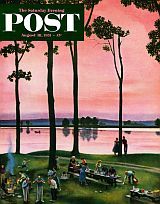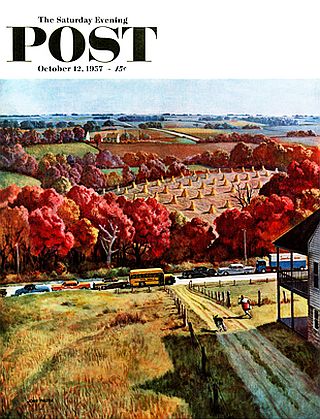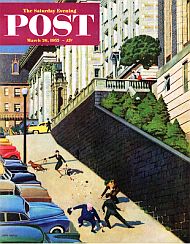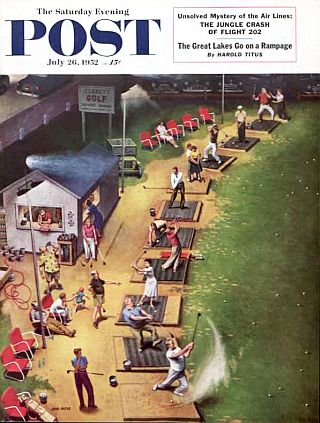
Artist John Falter’s painting, “Golf Driving Range,” was used to illustrate the cover of the July 26, 1952 “Saturday Evening Post,” one of some 129 covers he did for the magazine.
On an Antiques Roadshow first broadcast from Birmingham, Alabama in June 2014, and rebroadcast in early April 2015, a painting by artist John Falter (1910-1982) used to illustrate the cover of the July 26th, 1952 Saturday Evening Post shown at right, was assigned an insurance value of up to $250,000.
“I would put an insurance value of about $200,000 to $250,000 on it,” said Alan Fausel, the Roadshow’s appraiser during the segment presenting Falter’s painting. It was brought in by a Roadshow guest. The appraiser here was talking about the original painting by Falter that was used for the magazine cover – not the magazine cover itself. Still, that Falter’s work – and by extension, other illustration artists of that era of similar skill – could fetch that amount of money, certainly got the attention of viewers, and shortly thereafter, the Twitterverse and beyond. Appraiser Alan Fausel also commented during the show that “illustration art is one of the hottest things in the American art market today.” According to the Antiques Roadshow website, the owner of the Falter painting, “Golf Driving Range,” later sold the painting at auction in November 2014 for $197,000.
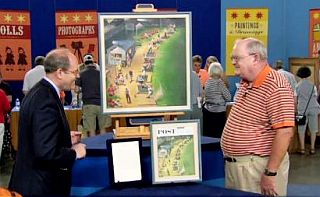
November 2014: “Antiques Roadshow” appraiser (L) with owner (R) of John Falter painting, magazine cover & letter.
In that transaction, John Falter included a letter to the buyer explaining the genesis of the painting and some description of it subjects.
When the owner’s son – the Roadshow guest in Birmingham, Alabama – inherited the painting, he still had the original Falter letter, which is valuable “provenance” as they say in the art appraisal trade, and more valuable coming from the artist himself. Together with the painting, of course, it made for a more valuable “package.”
The Falter painting, “Golf Driving Range,” captured a bit of popular 1950s Americana and recreation activity, as golf driving ranges such as that depicted were then sprouting up all over suburbia. And many were open at night as well, also as illustrated in Falter’s piece. Golf in post-WWII America was becoming a middle class pursuit.The owner of the inherited John Falter painting sold it at auction in November 2014 for $197,000. By 1953, the Tam O’Shanter World Championship golf tournament near Chicago was the first to be nationally televised. Falter too, it turns out, was something of a frustrated golfer himself, as he would explain in his 1978 letter to the buyer: “The idea of this cover,” he would write, “came from the frustrations of the artist to solve the mysteries of Golf.” Falter noted that he had early experience with the game as a youth in Nebraska – with “corn field golf that considered sand greens total luxury.” Later, after WWII when Falter was living on the East Coast, he picked up the game again, becoming something of a self-described “golf nut,” trying still to decipher the game’s secrets. So when he painted “Golf Driving Range” in 1952 he had some first-hand experience with the game’s difficulties – and enough to know about its golf-swing frustrations, which he comically depicted in his painting, all explained in his letter below (here, taking some liberties with punctuation):
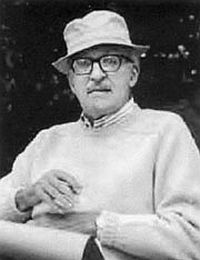 |
“…The scene of the cover is a [golf driving] range out on Rockville Pike, Bethesda [Maryland]. Probably gone now. I tried to represent all of the bad swings in golf, as I know them – and I should know, I had them all. [Describing the various “swings” from the top of the painting]: The anger shot; the no energy swing; the overextended back swing; the embraceable you shot; Bobby Jones the change of pace; The eager beaver; The irritator who always looks good but can’t hit; The lesson; The Fall back; the Fall forward. There are probably a lot more that I would have learned had I not been stopped by arthritis…”
In closing his letter Falter noted, “It’s a grand old game,” then adding a touch of humor, “and I have low handicap — on the tube.” ( here, presumably, he meant as a TV viewer ).
But to the good fortune of art, and not golf, and for nearly two decades from the 1940s through 1961, Falter turned out 128 other covers for The Saturday Evening Post – and these were only a portion of the more than 5,000 paintings he did during his lifetime. A selection of some of his Saturday Evening Post covers follows below, along with background on his career, the times, and his subject art. It should be noted, however, regarding the cover art below, that the original Saturday Evening Post magazine was a large-format magazine, nearly 11″x 15″ in size, so the artist’s detail and color quality would be much sharper in the actual magazine – one reason why millions of Americans in those days looked forward to seeing their weekly Saturday Evening Post. Still, the quality of Falter’s work shines through, even in these smaller examples.
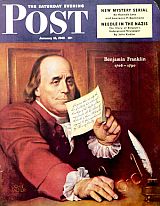 Ben Franklin, January 1943. |
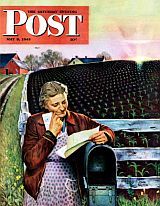 Ltr From Overseas, May 1943. |
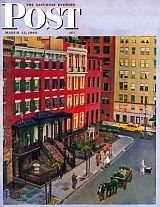 Gramercy Park, NY, 1944. |
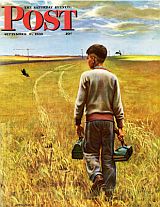 Amber Waves..., Sept 1945. |
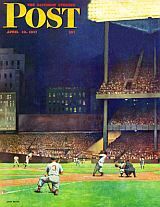 Yankee Stadium, April 1947. |
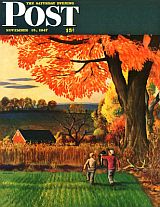 Fall scene, November 1947. |
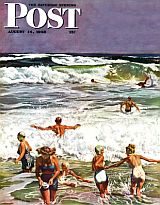 Surf Swimming, August 1948. |
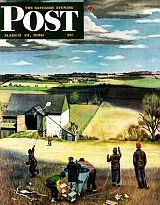 Flying Kites, March 18, 1950. |
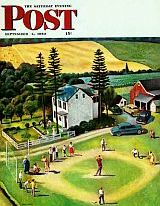 Family Baseball, Sept. 1950. |
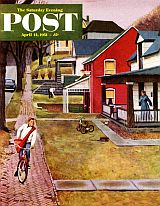 Paperboy, April 14, 1951. |
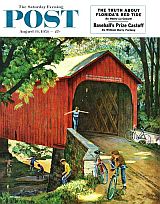 Covered Bridge, August 1954. |
|
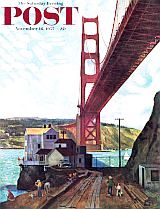 Golden Gate, Nov 1957. |
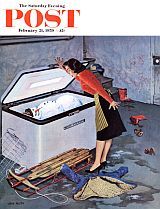 Frosty in Freezer, Feb 1959. |
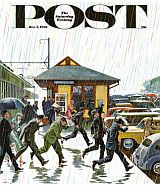 Commuters in Rain, Oct 1961. |
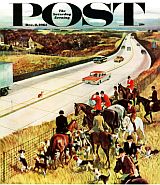 Foxhunters Outfoxed ,1961. |
John Falter
Born in Plattsmouth, Nebraska, John Phillip Falter began his artistic career by creating a comic strip when he was a high school student. A cartoonist at the Des Moines Register newspaper in Iowa – Pulitzer Prize-winner J. N. “Ding” Darling – saw some of Falter’s cartoons and said he should become an illustrator.
After high school, John Falter set off on his art education. Among his pursuits and learning experiences: he studied at the Kansas City Art Institute; won a scholarship to the Art Students League of New York City (which he did not complete); took courses during the Depression at the Grand Central School of Art above New York’s Grand Central station; and with three friends from his days at the Kansas City Art Institute, set up shop in New Rochelle, NY where he and they launched their respective careers as freelance illustrators.
In 1933, Falter received a major break with his first commission from Liberty Magazine. He was hired to do three illustrations a week. “They paid me $75 a week,” Falter said, “just like a steelworker. But my expenses for models and costumes were running $35 a week during one 16-week serial I was illustrating.”
Falter soon discovered there was better money to be made doing advertising illustrations. By 1938, he had begun doing ads for Gulf Oil, Four Roses Whiskey, Arrow Shirts, and Pall Mall cigarettes. Many of these ads appeared in the national magazines of that era. Falter found in fact, that his advertising work gave him enough income to explore other avenues of art, including easel painting.
With the outbreak of WWII, Falter joined the war effort, enlisting in the Navy in 1943. Eventually rising to the rank of Chief Petty Officer, Falter’s artistic talents were used in the war effort, designing over 300 recruiting posters.
Some of Falter’s wartime posters focused on security concerns of the time and about causal conversation leaking information to the enemy. One of his posters featured a Navy man heading off to duty, duffle bag on shoulder, with the caption, “If you tell where he’s going, he may never get there.” He also did a series of recruiting posters for the women’s Navy, the WAVES. And later for Esquire magazine, he did a series depicting 12 Medal-of-Honor winners.
Falter’s first Saturday Evening Post cover, a portrait of the magazine’s historic founder, Benjamin Franklin, appeared with the September 1st, 1943 issue. That began a 25-year association between Falter and the Post, during which he developed his own unique style. Falter’s eye for America and its people was aptly suited to the distinctly American story the Post sought to convey to its readers each week.
“There were plenty of Rockwell imitators and J. C. Leyendecker imitators,” Falter explained of two of the more famous Saturday Evening Post illustrators. “My main concern in doing Post covers was trying to do something based on my own experiences. I found my niche as a painter of Americana with an accent of the Middle West. I brought out some of the homeliness and humor of Middle Western town life and home life. I used humor whenever possible.”
Most of Falter’s Post covers were his own ideas. “Four didn’t make it,” he said, in one interview, and “probably 12 ideas were supplied by the Post.”
After the war, Falter moved to Saint Davids Street in the Chestnut Hill section of Philadelphia, where he was closer to the offices of The Saturday Evening Post and its owner, Curtis Publishing. In addition to his Saturday Evening Post illustrations, Falter also did work for other Curtis magazines, including Country Gentleman and Ladies Home Journal. He also did work for rival magazines, such as Reader’s Digest, Life, and Look.
As can be seen in the selection of his covers included with this story, there is a clear American style and tone about Falter’s Saturday Evening Post art, whether capturing the beauty of a Nebraska wheat field, the vivid colors of fall, or a simple, everyday scene of a newspaper boy on his bike – this last, an everyday occurrence in 1951 when it was painted, but today, a wistful part of a fading Americana.
Falter was dedicated to his craft. “It has to be a love affair every time,” he would say about his subject art. “If you aren’t in love with what you are trying to put on that canvas, you better quit.” Still, when viewing his completed works, he would always see something to improve. But most viewers, without his hard-judging eye, only saw very good illustration.
“John Falter’s work was less about people and more about settings,” wrote Diana Denny, describing his work in a 2012 story for SaturdayEveningPost.com. “It was all about perspective…”
While there are often people in Falter’s Saturday Evening Post work, those covers depicting outdoor themes in particular, stress the larger nature scene and not the people. In some respects, in these paintings the people are only bit players, secondary to the scene; made small in comparison to the larger majesty of a river, rolling landscape, moonlit night, etc. In “Evening Picnic,” shown earlier above, there is a well-crafted and detailed picnic scene with people engaged in all the requisite activities. Yet the “star” in this illustration is clearly the pink evening sky reflected on a glassy lake, accented by a few the tall trees. Again, in his “Running for the Bus,” a 1957 Saturday Evening Post cover shown at right, the child running down the lane to catch the school bus, and the local traffic jam made in the waiting, are only the smallest parts of this scene, which glories in the larger natural setting, its productive color, and it agricultural yield. Here, the human activity appears incidental. It’s as if Falter is purposely saying how small we all are when placed against the larger beauty of the world around us. Perspective indeed. In fact, Falter’s panoramic covers with long views and small people were something of a departure from the Post’s traditional close-up designs. Other Post illustrators, including Norman Rockwell, adopted the style for a time. In fact, Rockwell had high praise for Falter generally, calling him “one of America’s most gifted illustrators.”But like Rockwell and other of the Post illustrators, John Falter’s art used humor frequently, which also fit the Americana imagery the Post sought to convey. Falter’s humor often revolved around American families, children, and teenagers. “Frosty in the Freezer,” for example, from 1959 and shown earlier, is a clever Falter subject along these lines. Another is, “Learning to Fly,” a June 1953 cover, shown below left, which aptly captures the humor and parental concern for an adventuresome son convinced that he has devised the perfect personal flying apparatus. Falter features him atop the family garage about to make a test run. Mom and Dad, of course, are shown pleading for some sanity. Falter also shows a grandparent and a few neighbors, all out on their porches or back yards looking on as the boy gets set to “test his wings,” so to speak – mattress below at the ready (the painting for this cover would later be included in a Heritage Auctions catalog of October 2008 with an estimated sale price of between $40,000 and $60,000.
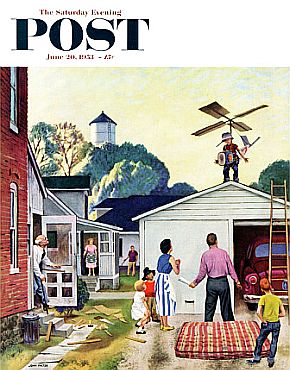 John Falter’s “Learning to Fly,” Saturday Evening Post, June 20, 1953. |
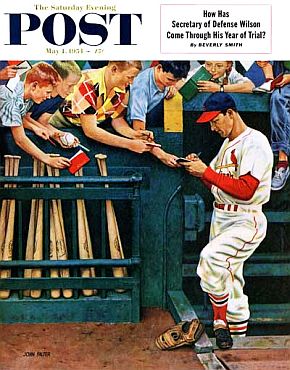 John Falter’s “Stan The Man” (Stan Musial, St. Louis Cardinals), Saturday Evening Post, May 1, 1954. |
Falter, and other Post illustrators, also had time for baseball in one form or another. He did a couple baseball themed- covers depicting family and sandlot games, and also one with an actual baseball great, Stan Musial, of the St. Louis Cardinals, shown signing autographs at the edge of a dugout during a big league game – and aptly titled “Stan the Man,” the fan-based moniker he was known by in those years.
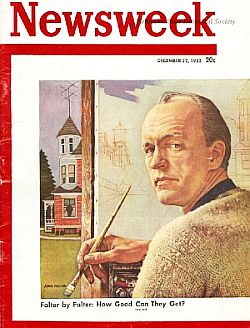
A self-portrait of a younger John Falter is used for a December 22, 1952 Newsweek cover story about him.
A Golden Era
For any magazine illustrator of the mid-1940s through early 1960s, The Saturday Evening Post was the place to be. Millions read it weekly, and the cover illustration each week was sort of the YouTube or Instagram of its day – making a visual statement of some kind about the nation, its people, its culture.
But the Post was not immune to the vagaries of a changing world and its economic demands. Falter, Rockwell, and other illustrators who had drank deeply from the golden cup that was The Saturday Evening Post, might have thought that their world would go on forever. But times change.
“I was sort of going along on a ship that would never sink,” Falter himself would later say. “It seemed that nothing could possibly happen to the Post. Then suddenly, in my middle life, I had to retool…”
By the early 1960s, photography was coming on strong, elbowing illustrators off magazine covers. And TV was making inroads on magazine advertising, leading eventually to the demise of the big, general interest and picture magazines of that era. The Saturday Evening Post was the first to go, but in later years, the other big magazines went under as well.
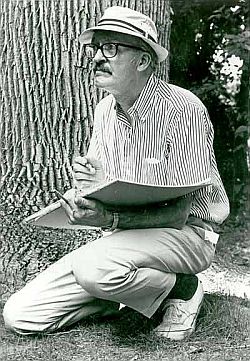
|
By 1963, illustrated covers at The Saturday Evening Post had gone by the wayside as photography moved in. Illustration art had become unfashionable. Once famous illustrators were now scrambling. Falter, for one, was forced to spend much of his savings to stay afloat and regain his footing. He turned to portrait painting and book illustration. Clark Gable, James Cagney, Olivia de Havilland, and other celebrities had portraits done by Falter. Among the 40 books he illustrated was a special edition of Carl Sandburg’s Abraham Lincoln – The Prairie Years and also Houghton-Mifflin’s series on Mark Twain. Jazz nightclubs and jazz muscians were also part of Falter’s territory, having been a self-taught jazz clarinet player in the 1920s. He painted scenes of Harlem nightclub life in the 1930s, and later did portraits of famous jazz musicians. He would sometimes sketch at clubs such as Eddie Condon’s on West 52nd St in New York City. In the mid-1970s, the 3M Company commissioned him to do a series of six paintings in celebration of the American Bicentennial, titled “From Sea to Shining Sea.” Paintings of the Old West became another Falter specialty. One of his projects in this area consisted of some 190 scenes, painted on separate canvases, depicting the western migration from the Missouri River to the Rocky Mountains. He continued working into the early 1980s. However, in May 1982, after a stroke and resulting complications, John Falter died at the University of Pennsylvania Hospital in Philadelphia. He was 72. His ashes were later cast into the Platte River, flowing into the Missouri, a subject of his western paintings. John Falter’s work lives on today, on display in numerous galleries and continuing to rise in value among collectors.
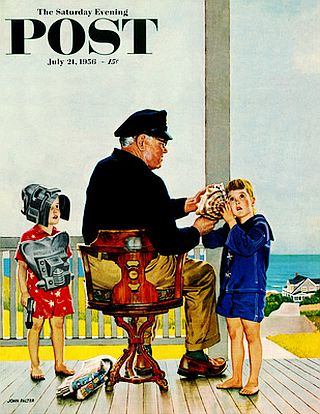 John Falter’s “Listening to the Sea,” Saturday Evening Post cover, July 21, 1956. |
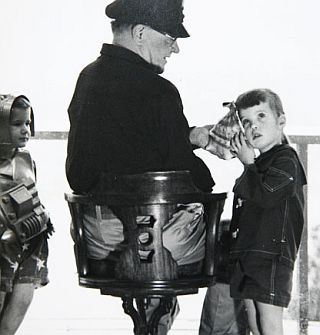 Photo of sketch setting brought into “Antiques Roadshow,” 2007, by Falter’e step-daughter, the girl in the painting. |
Earlier Roadshow
Other work of John Falter’s appeared on an earlier Antiques Roadshow program – prior to the “Golf Driving Range” painting that is described at the top of this article. In 2007-2008, Falter’s “Listening to the Sea” painting — which appeared as a July 1956 Saturday Evening Post cover — came to a Roadshow broadcast from Louisville, Kentucky. The painting came via Falter’s step daughter, who had appeared in the painting as the little girl subject holding the seashell to her ear, shown at left. Falter’s step daughter also had a photograph of that setting, with her as the little girl with the seashell.
“We were posing for my stepfather, John Falter, who was one of the artists painting for The Saturday Evening Post,” explained Falter’s step-daughter on the Roadshow segment. “We were in my stepfather’s studio, outside San Francisco, and the background [in the painting] is all creative license.” The boy, also in the photo and painting, dressed in something of space suit, was a neighbor. They were both about 5 years old at the time.
The Roadshow’s appraiser, Kathleen Guzman explained at the time that Falter’s art had not risen to the “Norman Rockwell level,” but that there was “a lot more interest in this kind of second-tier sort of artist.” About ten years ago, or earlier, she explained, “this was a very hard thing to sell,” and that buyers weren’t really looking for that kind of art then. “The market price on a picture like this was barely $5,000 to $7,000,” she explained. “It crept up to $10,000 to $15,000.” She then asked her guest how much she thought the painting might be valued at? The guest replied, “$50,000.”
Guzman suggested there had been a surge in price, which “has only happened in the past five years.” Although it wasn’t “record-breaking, to the point of Rockwell,” prices for Falter’s work, she said, were rising. She noted that “a few years ago,” a Saturday Evening Post painting by Falter of Yankee Stadium (shown earlier above) “at auction, brought $150,000.” Guzman acknowledged that the subject, being Yankee Stadium, as depicted in the 1947 cover, made it “kind of a specialized category.” Turning to the art at hand, the appraiser, Ms. Guzman continued: “This subject, though, is just as wonderful. As a presale auction estimate, something like this we would put between $100,000 to $150,000. Okay. And I’m sure, since this is an heirloom… I would say for an insurance value, you should put at least $175,000 on it.”
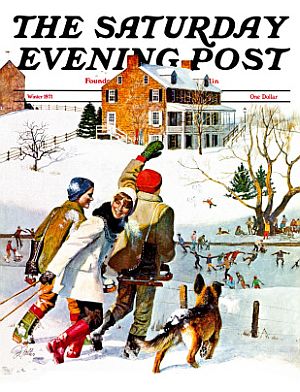
John Falter’s “Ice Skating in the Country,” for the December 1st, 1971 Saturday Evening Post.
One of the works featured was a panoramic piece Falter had painted of a snowy winter scene in Pennsylvania, a portion of which was later used for the cover of The Saturday Evening Post “Winter 1971″ issue shown at right. This cover, with old-style title lettering, came when the Post was operating under different ownership and published much less frequently. The cover also marked the last time (to date) that a Falter painting would appear on a Saturday Evening Post cover.
The full panoramic painting Falter did of the Pennsylvania winter scene was the auction item, and was given an estimated value of $30,000 to $50,000. It is not known if this particular painting was actually sold at the time or at what price. More recently, however, sale prices were posted on three other Falter paintings sold at a 2014 Christie’s auction, discussed below.
Falters at Christie’s
During an American art sale held at Christie’s auction house in New York city in February 2014, three John Falter paintings that were used for Saturday Evening Post covers were sold at auction for premium prices and well above pre-sale estimates. The three Falter paintings, which were acquired in the late 1960s, were put up for sale by “a distinguished family collection,” according to Christie’s.
Falter’s “Fifth Avenue” painting, shown below left, only a portion of which was used for The Saturday Evening Post cover of March 19, 1960 (was a larger fold out cover), sold at auction in its full version to a private buyer at a price of $461,000. His “Spilled Purse on Steep Hill,” shown below middle (lady losing the contents of her purse while walking a dog, as three gentlemen passing by attempt to retrieve her items), used for The Saturday Evening Post cover of March 26, 1955, sold for $131,000. The buyer in this case was the American Illustrators Gallery of New York city. Also bought by the American Illustrators Gallery at the same auction was Falter’s “Chasing the Fire Engine,” at a price of $106,250. This painting had been used as the cover illustration for The Saturday Evening Post of June 30, 1956.
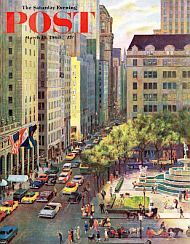 John Falter’s painting used for this March 1960 Sat Eve Post cover sold for $461,000 in Feb 2014. |
 John Falter’s painting used for this June 1956 Sat Eve Post cover sold for $106,250 in Feb 2014. |
Note: The works of John Falter shown in this piece are small representations of the actual full-size Saturday Evening Post covers that appeared in subscribers’ hands each week. For an excellent overview of John Falter’s 129 SEP covers, each in large size with annotation, see the John Philip Falter Museum website. Other examples of Falter’s covers are found at FullTable.com and VintagePoster Works.com.
Among other stories at this website that include history on Saturday Evening Post cover art and artists are: “John Clymer’s America”; “Rosie The Riveter, 1941-1945”; “Rockwell & Race, 1963-1968″; “The U.S. Post Office, 1950s-2011″; and “The Yogi Chronicles, 1940s-2012″ (Yogi Berra cover). Additional stories with magazine cover content include: “FDR & Vanity Fair, 1930s”; “Empire Newhouse, 1920s-2012”; and “Murdoch’s NY Deals, 1976-1977.” Thanks for visiting – and if you like what you find here, please make a donation to help support the research and writing at this website. Thank you. – Jack Doyle
|
Please Support Thank You |
____________________________________
Date Posted: 19 April 2015
Last Update: 2 April 2021
Comments to: jackdoyle47@gmail.com
Article Citation:
Jack Doyle, “Falter’s Art, Rising: Saturday Evening Post,”
PopHistoryDig.com, April 19, 2015.
____________________________________
Sources, Links & Additional Information
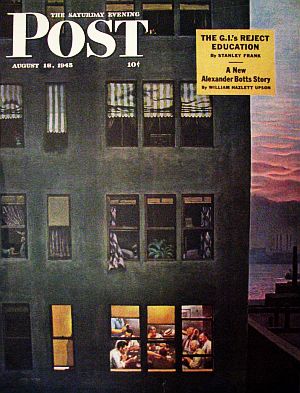 John Falter captures an “all-night-at-the-office” poker game for the Saturday Evening Post, August 18, 1945. |
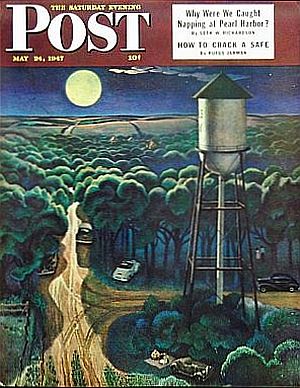 John Falter’s moonlit "Lovers' Lane, Falls City, Nebraska," Saturday Evening Post cover, May 24, 1947. |
Dylan Hayley Leavitt, “The Mysteries of Golf: What’s In A Swing?,” Antiques Roadshow, April 6,2015.
‘Antiques Roadshow:’ Saturday Evening Post Art Worth $250K,” AOL.com, April 7th, 2015.
John Falter Page, SaturdayEveningPost.com, October 22, 2014.
“John Philip Falter,” Wikipedia.org.
“Biography: John Philip Falter (February 28, 1910-May 20, 1982),” SaturdayEveningPost .com.
John Falter Gallery, Art.com.
“John Falter,” Field Guide To Wild American Pulp Artists, PulpArtists.com.
Diana Denny, “Remembering Artist John Falter,” SaturdayEveningPost.com, August 5, 2011.
Diana Denny, “Classic Covers: John Falter’s August,” SaturdayEveningPost.com, August 10, 2012.
John Falter, “Saturday Evening Post Illustration,” Antiques RoadShow, April 21, 2008, Louisville, KY, Hour 1, #1213 (appraised value: $100,000 – $175,000; appraised July 28, 2007, Louisville, KY, Appraiser: Kathleen Guzman).
“Through Falter’s Eyes,” Heritage Auctions, Inc., Heritage Auctions Illustration Art Auction Catalog, #7001, pp. 42-44. Illustration Art Auction, Dallas TX, October 15, 2008.
John Philip Falter (1910-1982), “Fifth Avenue” (and others), Christies.com.
Magazine Image Gallery, CurtisPublishing .com.
Joseph Scales, “Beyond the Canvas: Imagination Survives Despite the Influence of Television,” SaturdayEveningPost.com, April 8, 2014.
John Falter Gallery, FullTable.com.
1945 John Falter “Office Poker Party” Saturday Eve Post Poster, Original Vintage, Vintage PosterWorks.com.
1946 John Falter “Steam Engine Along the Missouri,” Saturday Eve Post Poster, Vintage PosterWorks.com.
1947 John Falter “Lovers’ Lane, Falls City, Nebraska,” Saturday Eve Post Poster, Vintage PosterWorks.com.
__________________________
